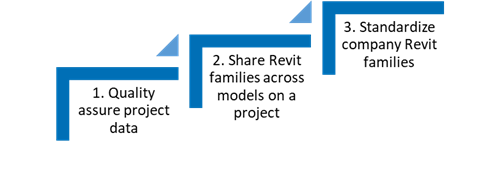
There are 3 high-level approaches to the use of NTI CONNECT
cloud platform.

Benefits:
•This can be done with existing and ongoing projects - No prerequisites required.
•Everyone can easily access and view data.
•No need for Revit knowledge.
•Overview of data across models in one place - No need to open multiple models.
•Export to Excel.
Keep in mind:
•Quantities are split by model, so make sure to use project or account building parts if it is important to gather these.
Get started:
•How to connect Revit model to NTI CONNECT project
•How to synchronize data between NTI CONNECT and Revit
2. Share Revit types between Revit project models
Benefits:
•Geometry is correct across the project models – This ensures the quality in the project material.
•Users of Revit will automatically be notified of a family change – Saves time and makes sure that models are up to date.
•Quantities are summed across models – No need to manually handle it in Excel.
Keep in mind:
•The Revit project model has to be synchronized frequently to make sure that the project is kept in sync.
Get started:
•Share building parts on projects
3. Standardize company building parts and use these on projects
Benefits:
•Revit families that are used on the projects are pre-approved and comply with the company standard.
•Changes to Revit families can be updated centrally and downloaded on projects.
•Company-specific parameters can be added.
•Quick for users to find a family and insert into the model.
Keep in mind:
•Changes to Revit families that are general for the company standard should be made in the catalog model.
Get started:
•Create building part standard
•How to insert building parts in Revit
You can find more lower-level workflows on the sub-pages below